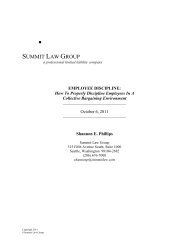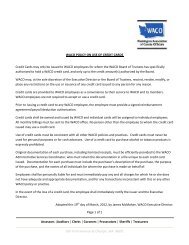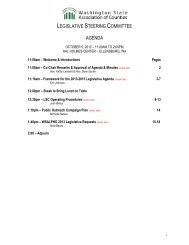2012 LFO Report - Wacounties.org
2012 LFO Report - Wacounties.org
2012 LFO Report - Wacounties.org
- No tags were found...
You also want an ePaper? Increase the reach of your titles
YUMPU automatically turns print PDFs into web optimized ePapers that Google loves.
HistoryDuring its 2003 session, the Washington State Legislature enacted ESSB 5990 into law inChapter 379, Laws of 2003. This legislation, in conjunction with the Governor’s proposedbudget for the following biennium, effected significant changes on the <strong>org</strong>anizational structureand functioning of DOC and on the process for collection of criminal <strong>LFO</strong>s within this State.The Governor’s initial proposal included shifting collection responsibility to the StateDepartment of Social and Health Services (DSHS). Because all <strong>LFO</strong> data is provided fromclerk-generated financial data, because <strong>LFO</strong>s originate from criminal court orders (Judgmentsand Sentences), and concern that DSHS’ historic emphasis, expertise and statutorily mandatedpriority has been in the civil and family law areas, the clerks proactively negotiated forcollections to be turned over to them to handle and manage.The resulting legislation, in summary, provides that individuals convicted in a Superior Court inthis state undergo a risk assessment by DOC, and are assigned a risk management designationranging from “A” to “D,” with “A” representing the highest risk to the community. Subject tocertain exceptions DOC is no longer responsible for supervision of those offenders receiving arisk management rating of “C” or “D.” Responsibility for collection of <strong>LFO</strong>s was transferred tothe county clerk for each respective county for all non-DOC supervised offenders.Responsibility for monthly billing was transferred from DOC to AOC. These changes werephased in between July, 2003 and January 1, 2004.In July, 2003, DOC began closing the cases that they were no longer involved with, pursuant toESSB 5990, and transferring them to the respective clerk’s offices. In October 2003, the clerksbecame legislatively enabled to take many of the administrative collection actions that had beenreserved to DOC prior to that time. In January 2004, AOC assumed responsibility for themonthly billing of obligors. At that time, AOC sent approximately 79,000 statements eachmonth.The initial formula for distribution of these funds was based upon the relative volume of criminalsentences entered in each county during the years 1998 through 2002. 2 Table #3 in the appendixcontains the data used to distribute these funds. In 2010, WSACC voted to modify thedistribution of funds by updating the sentencing statistics to the years 2005-2009, 3 and to evenout the distribution of the funding between years one and two of each biennium. The updatedsentencing data and distribution formula can be seen in Table 4 in the appendix. This fundingdistribution formula includes additional funding that was requested and approved by thelegislature in 2009. The additional funding approved adds $81,000 per year, or $162,000 perbiennium, and perhaps more importantly ties this funding to annual cost-of-living adjustments.When the legislation was originally passed, RCW 2.56.190 was enacted and it read in part: “ByOctober 1, 2003, and annually thereafter, the administrative office of the courts shall distribute2 The source of this data is the AOC Superior Court Statistics web site. See Table 3 in the Appendix.3 The source of this data is the AOC Superior Court Statistics web site. See Table 4 in the Appendix.________________________________________________________ ______________________________Washington Association of County Officials December <strong>2012</strong><strong>Report</strong> to the Washington State LegislatureOn the Fiscal Impact of ESSB 5990 Page 6 of 38






